Question 1.
Use Euclid’s division algorithm to find the HCF of
i) 900 and 270
Answer:
900 = 270 × 3 + 90
270 = 90 × 3 + 0
∴ HCF = 90
ii) 196 and 38220
Answer:
38220 = 196 × 195 + 0
∴ 196 is the HCF of 196 and 38220.
iii) 1651 and 2032
Answer:
2032 = 1651 × 1 + 381
1651 = 381 × 4 + 127
381 = 127 × 3 + 0
∴ HCF = 127
Question 2.
Use Euclid division lemma to show that any positive odd integer is of the form 6q + 1 or 6q + 3 or 6q + 5, where q is some integers.
Answer:
Let ‘a’ be an odd positive integer.
Let us now apply division algorithm with a and b = 6.
∵ 0 ≤ r < 6, the possible remainders are 0, 1, 2, 3, 4 and 5.
i.e., ’a’ can be 6q or 6q + 1 or 6q + 2 or 6q + 3 or 6q + 4 or 6q + 5, where q is the quotient.
But ‘a’ is taken as an odd number.
∴ a can’t be 6q or 6q + 2 or 6q + 4.
∴ Any odd integer is of the form 6q + 1, 6q + 3 or 6q + 5.
Question 3.
Use Euclid’s division lemma to show that the square of any positive integer is of the form 3p, 3p + 1.
Answer:
Let ‘a’ be the square of an integer.
Applying Euclid’s division lemma with a and b = 3
Since 0 ≤ r < 3, the possible remainders are 0, 1, and 2.
∴ a = 3q (or) 3q + 1 (or) 3q + 2
∴ Any square number is of the form 3q, 3q + 1 or 3q + 2, where q is the quotient.
(or)
Let ‘a’ be a positive integer
So it can be expressed as a = bq + r (from Euclideans lemma)
now consider b = 3 then possible values of ‘r’ are ‘0’ or ‘1’ or 2.
then a = 3q + 0 = 3q (or) 3q + 1 or 3q + 2 now square of given positive integer (a2) will be
Case - I: a2- (3q)2= 9q2=3(3q2) = 3p (p = 3q2)
Case-II: a2= (3q + l)2= 9q2+ 6q+ 1
= 3[3q2+ 2q] + 1 = 3p+l (Where p = 3q2+ 2q) or
Case - III: a2= (3q + 2)2= 9q2+ 12q + 4 = 9q2+ 12q + 3 + 1
= 3[3q2+ 4q + 1] + 1
= 3p + 1 (where ‘p’ = 3q2+ 4q + 1)
So from above cases 1, 2, 3 it is clear that square of a positive integer (a) is of the form 3p or 3p + 1
Hence proved.
Question 4.
Use Euclid’s division lemma to show that the cube of a positive integer is of the form 9m, 9m + 1 or 9m + 8.
(OR)
Show that the cube of any positive integer is of form 9m or 9m + 1 or 9m + 8, where m is an integer.
Answer:
Let ‘a’ be positive integer. Then from Euclidean lemma a = bq + r;
now consider b = 9 then 0 ≤ r < 9, it means remainder will be 0, or 1, 2, 3, 4, 5, 6, 7, or 8
So a = bq + r
⇒ a = 9q + r (for b = 9)
now cube of a = a3+ (9q + r)3
= (9q)3+ 3.(9q)3r + 3. 9q.r + r3
= 93q3+ 3.92(q2r) + 3.9(q.r) + r3
= 9[92.q3+ 3.9.q2r + 3.q.r] + r3
a3= 9m + r3(where ‘m’ = 92q3+ 3.9.q2r + 3.q.r)
if r = 0 ⇒ r3= 0 then a3= 9m + 0 = 9m
and for r = 1 ⇒ r3= l3then a3= 9m + 1
and for r = 2 ⇒ r3= 23then a3= 9m + 8
for r = 3 ⇒ r3, = 33⇒ a3= 9m + 27 = 9(m) where m = (9m +3)
for r = 4 ⇒ r3= 43⇒ a3= 9m + 64 = (9m + 63) + 1 = 9m + 1
for r = 5 ⇒ r3= 125 ⇒ a3= 9m + 125 = (9m + 117) + 8 = 9m + 8
for r = 6 ⇒ r3- 216 ⇒ a3= 9m + 216 = 9m + 9(24) = 9m
for r = 7 ⇒ r3= 243
⇒ a3= 9m + 9(27) = 9m
for r = 8 ⇒ r3= 512
⇒ a3= 9m + 9(56) + 8 = 9m + 8
So from the above it is clear that a3is either in the form of 9m or 9m + 1 or 9m + 8.
Hence proved.
Question 5.
Show that one and only one out of n, n + 2 or n + 4 is divisible by 3, where n is any positive integer.
(Or)
Show that one and only one out of a, a + 2 and a + 4 is divisible by 3 where ‘a’ is any positive integer.
Answer:
Let ‘n’ be any positive integer.
Then from Euclidean’s lemma n = bq + r (now consider b = 3)
⇒ n = 3q + r (here 0 ≤ r < 3) which means the possible values of ‘r’ = 0 or 1 or 2
Now consider r = 0 then ‘n’ = 3q (divisible by 3)
and n + 2 = 3q + 2 (not divisible by 3)
n + 4 = 3q + 4 (not divisible by 3)
Case - II: For r = 1
n = 3q + 1 (not divisible by 3)
n + 2 = 3q + 1 + 2 = 3q + 3 = 3(q + l) divisible by 3
n + 4 = 3q + 1 + 4 = 3q + 5 not divisible by 3
Case – III: For r = 2,
n = 3q + 2 not divisible by 3
n + 2 = 3q + 2 + 2 = 3q + 4, not divisible by 3
n + 4 = 3q + 2 + 4 = 3q + 6 = 3(q + 2) divisible by 3
So in all above three cases we observe, only one of either (n) or (n + 1) or (n + 4) is divisible by 3.
Hence proved.
Question 1.
Express each of the following numbers as a product of its prime factors.
- i) 140
- ii) 156
- iii) 3825
- iv) 5005
- v) 7429
Answer:
i) 140
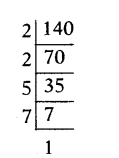
∴ 140 = 2 × 2 × 5 × 7 = 22 × 5 × 7
ii) 156
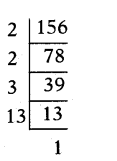
∴156 = 2 × 2 × 3 × 13 = 22 × 3 × 13
iii) 3825
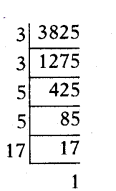
∴ 3825 = 3 × 3 × 5 × 5 × 17 = 32 × 52 × 17
iv) 5005
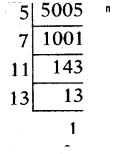
∴ 5005 = 5 × 7 × 11 × 13
v) 7429
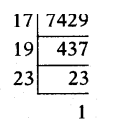
∴7429 = 17 × 19 × 23
Question 2.
Find the L.C.M and H.C.F of the following integers by the prime factorization method.
- i) 12, 15 and 21
- ii) 17, 23 and 29
- iii) 8, 9 and 25
- iv) 72 and 108
- v) 306 and 657
Answer:
i) 12, 15 and 21
12 = 2 × 2 × 3 = 22 × 3
15 = 3 × 5
21 = 3 × 7
L.C.M = 22× 3 × 5 × 7 = 420
H.C.F = 3
ii) 17, 23 and 29
The given numbers 17, 23 and 29 are all primes.
L.C.M = their product
= 17 × 23 × 29 = 11339
∴ H.C.F = 1
iii) 8, 9 and 25
8 = 2 × 2 × 2 = 23
9 = 3 × 3 = 32
25 = 5 × 5 = 52
L.C.M = 23× 32× 52= 1800
(or)
8, 9 and 25 are relatively prime, therefore L.C.M is equal to their product,
(i.e.,) L.C.M = 8 × 9 × 25 = 1800
H.C.F = 1
iv) 72 and 108
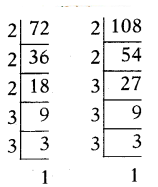
72 = 23× 32
108 = 22× 33
L.C.M = 23× 33= 8 × 27 = 216
H.C.F = 22× 32= 4 × 9 = 36
v) 306 and 657
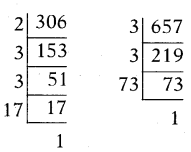
306 = 2 × 32× 17
657 = 32 × 73
L.C.M = 2 × 32× 17 × 73 = 22338
H.C.F = 32= 9
Question 3.
Check whether 6ncan end with the digit ‘0’ for any natural number n.
Answer:
Given number = 6n= (2 × 3)n
The prime factors here are 2 and 3 only.
To be end with 0; 6nshould have a prime factor 5 and also 2.
So, 6ncan’t end with zero.
Question 4.
Explain why 7 × 11 × 13 + 13 and 7 × 6 × 5 × 4 × 3 × 2 × 1 + 5 are composite numbers.
Answer:
Given numbers are 7 × 11 × 13
7 × 6 × 5 × 4 × 3 × 2 × 1 + 5
⇒ 13(7 × 11 + 1) and
5(7 × 6 × 4 × 3 × 2 × 1 + 1)
⇒ 13 K and 5 L, where K = 78 and L = 7 × 6 × 4 × 3 × 2 × 1 + 1 = 1009
As the given numbers can be written as product of two numbers, they are composite.
Question 5.
How will you show that (17 × 11 × 2) + (17 × 11 × 5) is a composite number? Explain.
Answer:
(17 × 11 × 2) + (17 × 11 × 5)
= (17 × 11) (2 + 5)
= (17 × 11) (7)
= 187 × 7
Now the given expression is written as a product of two integers and hence it is a composite number.
Question 6.
What is the last digit of 6100?
Answer:
We know that
61= 6
62= 36
63= 216
64= 1296
65= 7776
We see that 6nfor any positive integer n ends is 6.
i.e., unit digit is always 6.
∴ Unit digit of 6100is 6.
Question 1.
Write the following rational numbers in their decimal form and also state which are terminating and which have non-terminating repeating decimals.
i)3/8
ii)229/400
iii)4 1/5
iv)2/11
v)81/25
Answer:
i)3/8
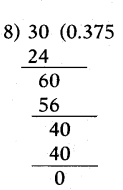
[!! Denominator 8 = 23, consists of only 2’s. Hence a terminating decimal.]
∴3/8= 0.375 is a terminating decimal.
ii) 229/400
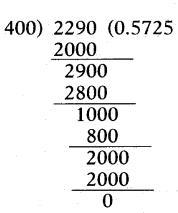
[!! Denominator 400 = 24 × 52 = 2n × 5m. Hence a terminating decimal.]
∴ 229400 = 0.5725 is a terminating decimal.
iii) 4 1/5
4 1/5 = 4 + 1/5

[!! Denominator is 5. Hence a terminating decimal.]
∴ 415 = 4.2 is a terminating decimal.
iv) 2/11
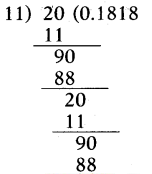
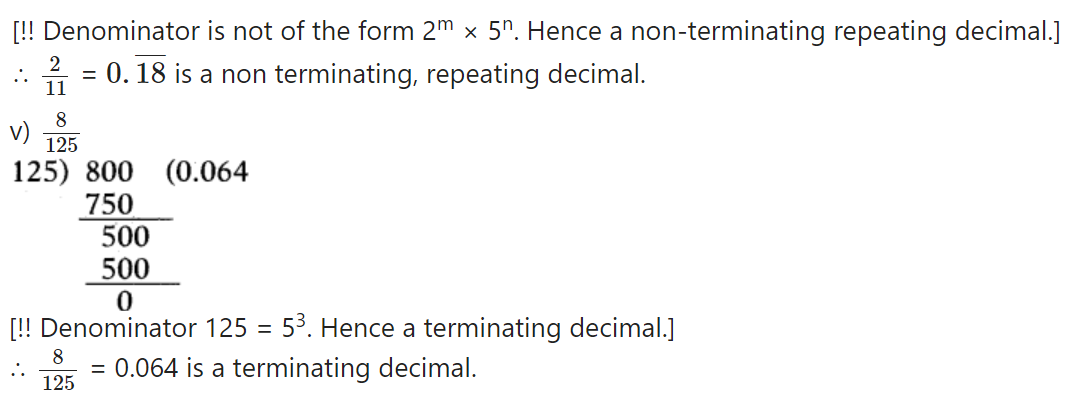
Question 2.
Without performing division, state whether the following rational numbers will have a terminating decimal form or a non-terminating, repeating decimal form.
- i)13/3125
- ii)11/12
- iii)64/455
- iv)15/1600
- v)29/343
- vi)23/2352
- vii)129/22.57.75
- viii)9/15
- iX)36/100
- X)77/210
Answer:
i)13/3125
Note: We check whether the denominator is of the form 2n. 5mor not? If yes, the rational number can be expressed as a terminating decimal. If not, it can’t be expressed as a terminating decimal.
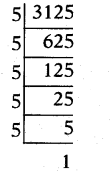
[!! Denominator is of the form 2m× 5n. Hence a terminating decimal.]
3125 = 55
∴13/3125is a terminating decimal.
ii)11/12
The denominator 12 is not a factor of 11. Moreover 12 = 22× 3.
[!! Denominator is not of the form 2m× 5n.]
∴11/12 is a non terminating, repeating decimal.
iii) 64/455
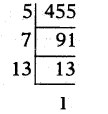
[!! Denominator is not of the form 2m× 5n. Hence a non terminating decimal.]
∴ 455 = 5 × 7 × 13
Hence 64/455 is a non terminating, repeating decimal.
iv) 15/1600
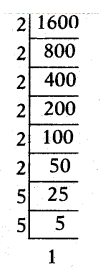
∴ 1600 = 26× 52[∵ The denominator is of the form 2n. 5m]
Hence 15/1600 is a terminating decimal.
v) 29/343

343 = 73[Not of the form 2n. 5m]
∴29343is a non terminating, repeating decimal.
vi)23/23.52
23/23.52is a terminating decimal.
[∵ The denominator is of the form 2n. 5m]
vii)129/22.57.75
129/22.57.75is a non terminating, repeating decimal.
viii)9/15
9/15=3/5
Denominator is of the form 2n. 5m.
∴915=35is a terminating decimal.
ix)36100
100 = 22× 52is of the form 2n. 5m
Hence36/100is a terminating decimal.
x) 77/210
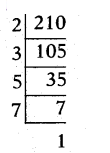
210 = 2 × 3 × 5 × 7 is not of the form 2n. 5m
Given fraction has a non-terminating, repeating decimal expansion.
Question 3.
Write the following rationals in decimal form using Theorem 1.4.
- i)1325
- ii)1516
- iii)23/23.52
- iv)7218/32.52
- v)143/110
Answer:
i)13/25
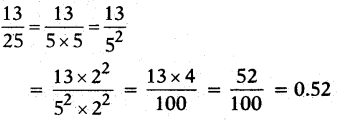
ii) 15/16
15/16 = 152×2×2×2
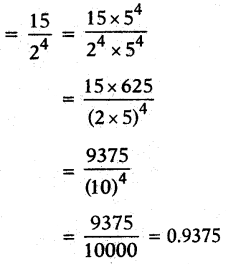
iii) 23/23?52
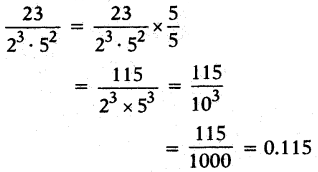
iv) 7218/32?52
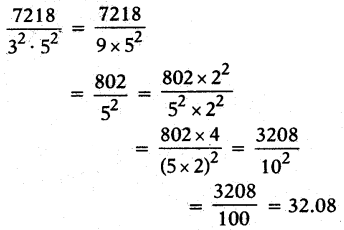
v) 143/110

Question 4.
The decimal form of some real numbers are given below. In each case, decide whether the number is rational or not. If it is rational, and expressed in form p/q, what can you say about the prime factors of q?
i) 43.12345678?
ii) 0.120120012000120000 ……….
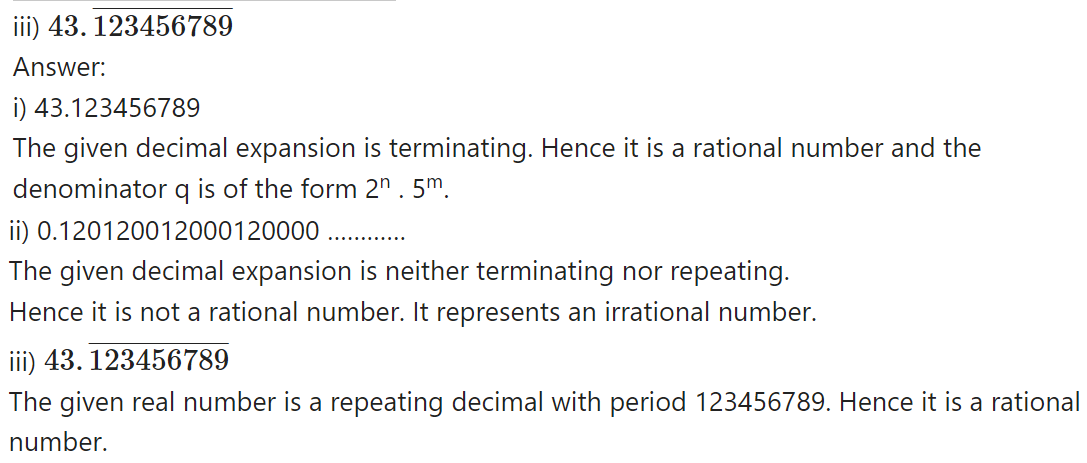
Question 1.
Prove that the following are irrational,
i)1/√2
ii) √3 + √5
iii) 6 + √2
iv) √5
v) 3 + 2√5
Answer:
i)1/√2
On the contrary, suppose that is a 1/√2 rational number;
then 1/√2 is of the form wherepqand q are integers.
∴ 1/√2 = p/q
⇒ √2/1 =q/p
(i.e.,) √2 is a rational number and it is a contradiction. This contradiction arised due to our supposition that 1/√2 is a rational number.
Hence 1/√2 is an irrational number.
ii) Suppose √3 + √5 is not an irrational number.
Then √3 + √5 must be a rational number.
√3 + √5 = p/q, q ≠ 0 and p, q ∈ Z
Squaring on both sides
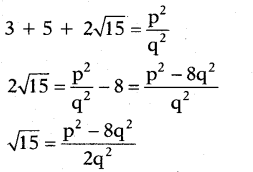
but √15 is an irrational number.
p2?8q2/2q2 is a rational number
(p2 - 8q2, 2q2 ∈ Z, 2q2 ≠ 0)
but an irrational number cant be equal to a rational number, so our supposition that √3 + √5 is not an irrational number is false.
∴ √3 + √5 is an irrational number.
iii) 6 + √2
To prove: 6 + √2 is an irrational number.
Let us suppose that 6 + √2 is a rational number.
∴ 6 + √2 = p/q, q ≠ 0
⇒ √2 = p/q - 6
⇒ √2 = Difference of two rational numbers
⇒ √2 = rational number But this contradicts the fact that √2 is an irrational number.
∴ Our supposition is wrong.
Hence the given statement is true.
6 + √2 is an irrational number.
iv) √5
To prove: √5 is an irrational number.
On the contrary, let us assume that √5 is a rational number.
∴ √5 = p/q, q ≠ 0
If p, q have a common factor, on cancelling the common factor let it be
reduces to a/b where a, b are co-primes.
Now √5 =a/b, where HCF (a, b) = 1
Squaring on both sides we get
⇒ (√5)2=(a/b)2
⇒ 5 =a2/b2
⇒ 5b2= a2
⇒ 5 divides a2and thereby 5 divides 5
Now, take a = 5c
then, a2= 25c2
i.e., 5b2= 25c2
⇒ b2= 5c2
⇒ 5 divides b2and thereby b.
⇒ 5 divides both b and a.
This contradicts that a and b are co-primes.
This contradiction arised due to our assumption that √5 is a rational number.
Hence our assumption is wrong and the given statement is true, i.e., √5 is an irrational number,
v) 3 + 2√5
To Prove: 3 + 2√5 is an irrational.
On the contrary, let us assume that 3 + 2√5 is a rational number.
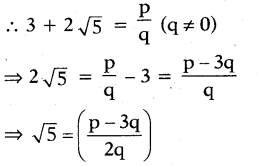
Here p, q being integers we can say that p-3q/2q is a rational number.
This contradicts the fact that √5 is an irrational number. This is due to our assumption “3 + 2√5 is a rational number”.
Hence our assumption is wrong.
∴ 3 + 2√5 is an irrational number.
Question 2.
Prove that √p + √q is an irrational, where p, q are primes.
Answer:
Given that p, q are primes.
Hence fp and fq are irrationals.
[∵ p, q have no factors other than 1 ∵ they are primes.]
Now √p + √q = sum of two irrational numbers = an irrational number
Hence proved.
Question 1.
Determine the values of the following,
i) log255
Answer:

ii) log813
Answer:
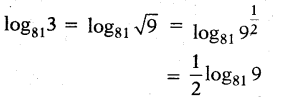
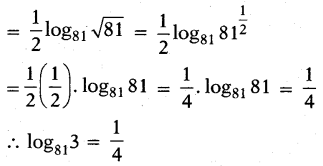
iii) log2(1 1/6)
Answer:
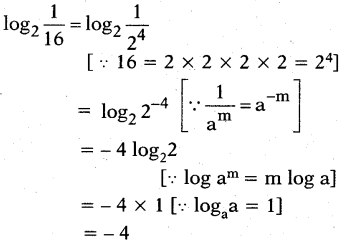
iv) log71
Answer:
log71 = log770= 0 log77 = 0
v) logx√x
Answer:
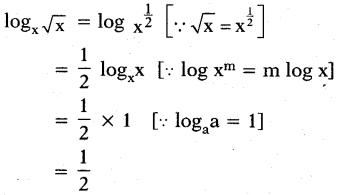
vi) log2512
Answer:
log2512 = log229 [∵ 512 = 29]
= 9log22[∵ log xm= m log x]
= 9 × 1 [∵ logaa = 1]
= 9
vii) log100.01
Answer:
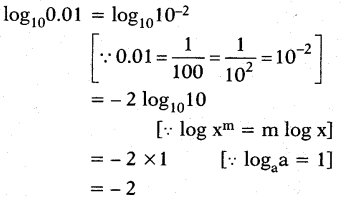
viii)log 2/3(8/27)
Answer:
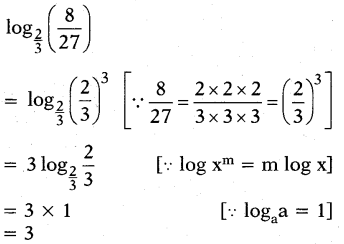
ix)22+log23
Answer:
22+log23= 22.2log2 3[∵ am. an= am+n]
= 4 × 3 [∵logaN= N]
= 12
Question 2.
Write the following expressions as log N and find their values.
i) log 2 + log 5
Answer:
log 2 + log 5
= log 2 × 5 [∵ log m + log n = log mn]
= log 10
= 1
ii) log216 - log22
Answer:
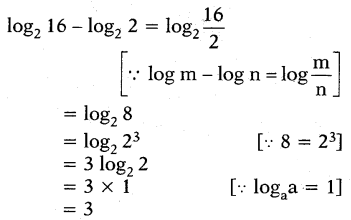
iii) 3 log644
Answer:
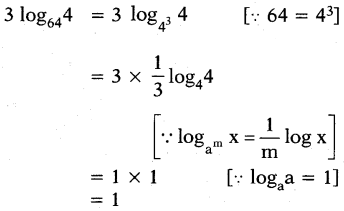
iv) 2 log 3 - 3 log 2
Answer:
2 log 3 - 3 log 2
= log 32 log 23
= log 9 - log 8
= log 9/8
v) log 10 + 2 log 3 - log 2
Answer:
log 10 + 2 log 3 - log 2
= log 10 + log 32 log 2
= log 10 + log 9 - log 2 [∵ m log a = log am]
= log 10×9/2 [∵ log a + log b = log ab; log a - log b = log a/b]
= log 45
Question 3.
Evaluate each of the following in terms of x and y, if it is given x = log23 and y = log25.
i) log215
Answer:
log215 = log23 × 5
= log23 + log25[∵ log mn = log m + log n]
= x + y
ii) log27.5
Answer:
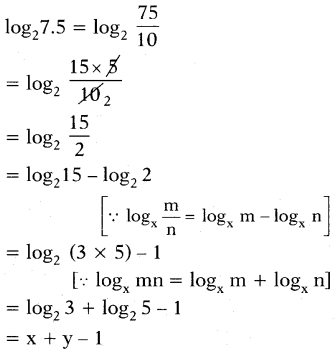
iii) log260
Answer:
log260 = log222× 3 × 5
= log222+ log23 + log25
= 2 log22 + x + y
= 2 + x + y
iv) log26750
Answer:
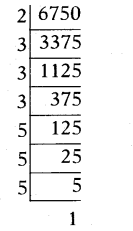
log26750
= log22 × 33× 53
= log22 + log233 + log253
= 1 + 3 log23 + 3 log25
= 1 + 3x + 3y
Question 4.
Expand the following,
i) log 1000
Answer:
log 1000 = log 103
= 3 log 10
= 3 × 1
= 3
ii)log[128/625]
Answer:
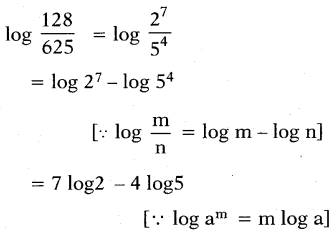
iii) log x2y3z4
Answer:
log x2y3z4= logx2+ logy3+ logz4[∵ log ab = log a + log b]
= 2 log x + 3 log y + 4 log z
[∵ log am= m log a]
iv)log p2q3/r
Answer:
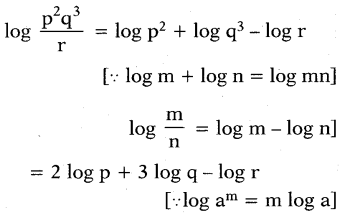
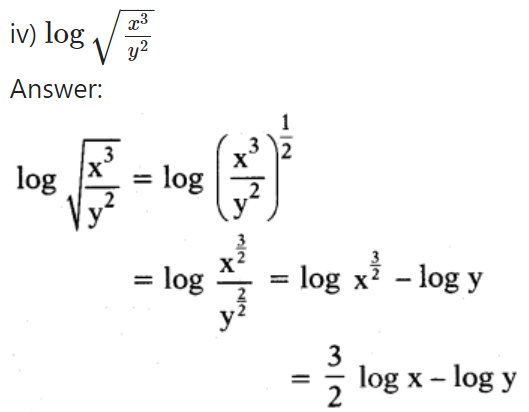
Question 5.
If x2+ y2= 25xy, then prove that 2 log (x + y) = 3log3 + logx + logy.
Answer:
Given: x2+ y2= 25xy
We know that (x + y)2= x2+ y2+ 2xy
= 25xy + 2xy [∵ x2+ y2= 25xy given]
(x + y)2= 27xy
Taking ‘log’ on both sides
log (x + y)2= log 27xy
2 log (x + y) = log 27 + log x + log y
= log 33+ log x + log y
⇒ 2 log (x + y) = 3log3 + log x + log y
Question 6.
If log (x+y/3)=1/2(log x + log y), then find the value of x/y + y/x.
Answer:
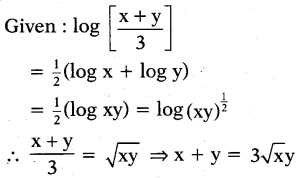
(squaring on both sides)
⇒ (x + y)2= (3√xy)2
⇒ x2+ y2+ 2xy = 9xy
⇒x2+ y2= 9xy - 2xy = 7xy

Question 7.
If (2.3)x= (0.23)y= 1000 then find the value of 1/x - 1/y.
Answer:
Given (2.3)x = (0.23)y= 1000 = 103
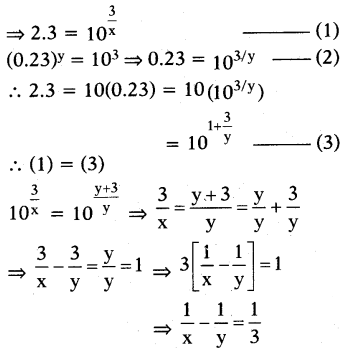
Question 8.
If 2x+1= 31-xthen find the value of x.
Answer:
Given: 2x+1= 31-x
log 2x+1= log 31-x
(x + 1) log 2 = (1 - x) log 3
x log 2 + log 2 = log 3 - x log 3
x log 2 + x log 3 = log 3 - log 2
x (log 3 + log 2) = log 3 - log 2

Question 9.
Is i) log 2 is rational or irrational? Justify your answer.
Answer:
Let log102 = x
Then 10x= 2
But 2 can’t be written as 10xfor any value of x
∴ log 2 is irrational.
ii) log 100 is rational or irrational? Justify your answer.
Answer:
Let log10100 = x
⇒ log10102= x
⇒ 2 log1010 = x = 2
∴ log 100 is rational.
∴ log 100 = 2
Hence rational.